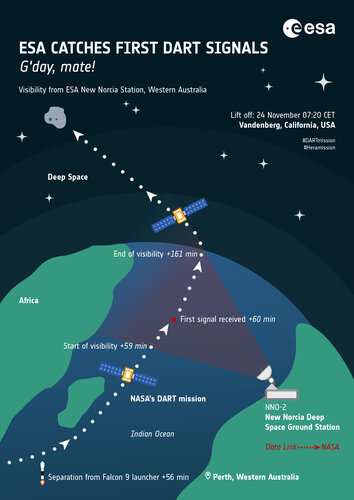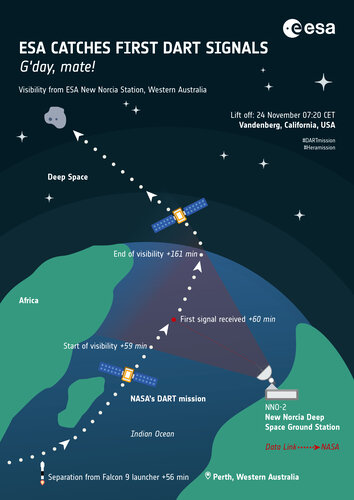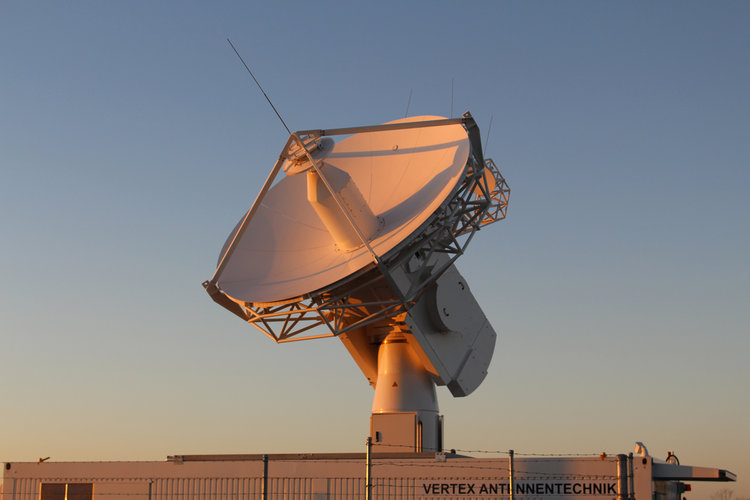
Copernical Team
Double Asteroid Redirection Test launch could be key step forward in planetary defense

NASA's latest launch into outer space is going to make an impact. In fact, that's its entire mission.
DART (Double Asteroid Redirection Test), which is scheduled to launch at 10:20 p.m. PST on Nov. 23 out of Vandenberg Air Force Base in California, is NASA's first planetary defense mission. This mission will demonstrate asteroid deflection via kinetic impact. The goal is to collide with the target to see how the orbit changes. It's a test run to see if such a plan is feasible should we find an asteroid on a collision course with Earth one day.
Cristina Thomas, an assistant professor of astronomy and planetary sciences at Northern Arizona University and lead of the DART Observations Working Group, is excited to see the effects of the impact. She and her international team have been working for years to obtain a precise pre-impact orbit of Dimorphos, the satellite asteroid, around Didymos, the primary asteroid in a near-Earth asteroid system.
Near-Earth, of course, is relative; the planet is in no danger from Didymos. However, an asteroid heading toward Earth is possible, and scientists throughout the world are working on ways to identify these potential threats and how to mitigate them.
An absolutely bonkers plan to give Mars an artificial magnetosphere

Terraforming Mars is one of the great dreams of humanity. Mars has a lot going for it. Its day is about the same length as Earth's, it has plenty of frozen water just under its surface, and it likely could be given a reasonably breathable atmosphere in time. But one of the things it lacks is a strong magnetic field. So if we want to make Mars a second Earth, we'll have to give it an artificial one.
The reason magnetic fields are so important is that they shield a planet from solar wind and ionizing particles. Earth's magnetic field prevents most high-energy charged particles from reaching the surface. Instead, they are deflected from Earth, keeping us safe. The magnetic field also prevents solar winds from stripping Earth's atmosphere over time. Early Mars had a thick, water-rich atmosphere, but it was gradually depleted without the protection of a strong magnetic field.
ESA antenna to catch DART's first words
 Image:
ESA's Australian ground station to catch DART's first words
Image:
ESA's Australian ground station to catch DART's first words ESA's Australian ground station to catch DART's first words
 Image:
ESA's Australian ground station to catch DART's first words
Image:
ESA's Australian ground station to catch DART's first words Catching asteroid deflection mission's first words

NASA Study Traces Decade of Ammonia Air Pollution in Africa
 A new NASA-led study is the first to document changing atmospheric ammonia (NH3) concentrations in Africa over an extended period. Ammonia is an air pollutant which can lead to heart and lung related illness. When present in excess in an ecosystem, it can make soil more acidic and hinder plant growth.
Ammonia is emitted naturally from soils and vegetation fires, but agricultural activities
A new NASA-led study is the first to document changing atmospheric ammonia (NH3) concentrations in Africa over an extended period. Ammonia is an air pollutant which can lead to heart and lung related illness. When present in excess in an ecosystem, it can make soil more acidic and hinder plant growth.
Ammonia is emitted naturally from soils and vegetation fires, but agricultural activities Now back, space station astronauts recall the view, a crisis and peppers they grew
 NASA's Crew-2 astronauts enjoyed spectacular views, camaraderie and fresh peppers grown in microgravity, but they also encountered challenging spacewalks and a crisis when part of the International Space Station malfunctioned, the four space flyers said Monday during a teleconference.
Astronauts Shane Kimbrough, Megan McArthur, Akihiko Hoshide and Thomas Pesquet gave their first p
NASA's Crew-2 astronauts enjoyed spectacular views, camaraderie and fresh peppers grown in microgravity, but they also encountered challenging spacewalks and a crisis when part of the International Space Station malfunctioned, the four space flyers said Monday during a teleconference.
Astronauts Shane Kimbrough, Megan McArthur, Akihiko Hoshide and Thomas Pesquet gave their first p NASA's Eyes on the Earth puts the world at your fingertips
 The 3D real-time visualization tool lets users track NASA satellites as well as the vital Earth science data they provide. Recent upgrades make for an even more fascinating experience. NASA's real-time 3D visualization tool Eyes on the Earth got a recent upgrade to include more datasets, putting the world at your fingertips. Using the tool, you can track the planet's vital signs - everything fro
The 3D real-time visualization tool lets users track NASA satellites as well as the vital Earth science data they provide. Recent upgrades make for an even more fascinating experience. NASA's real-time 3D visualization tool Eyes on the Earth got a recent upgrade to include more datasets, putting the world at your fingertips. Using the tool, you can track the planet's vital signs - everything fro Planet to acquire VanderSat to deliver advanced agriculture data products to customers
 Planet, a leading provider of daily data and insights about Earth, has entered into an agreement to acquire VanderSat, a leading provider of advanced earth data and analytics. VanderSat's innovative products help customers better measure and understand water management and crop health in major markets.
Planet intends to leverage VanderSat's technologies and products in further pursuit of b
Planet, a leading provider of daily data and insights about Earth, has entered into an agreement to acquire VanderSat, a leading provider of advanced earth data and analytics. VanderSat's innovative products help customers better measure and understand water management and crop health in major markets.
Planet intends to leverage VanderSat's technologies and products in further pursuit of b SES orders 2 new sats for Prime TV Neighbourhood serving 118 million homes
 SES has ordered two geostationary (GEO) Ku-band satellites for its prime orbital slot at 19.2 degrees East to maintain the premium services it provides to its European video customers and to capture new opportunities in the region. These two replacement satellites - ASTRA 1P and ASTRA 1Q - will be built by Thales Alenia Space, a joint venture between Thales (67%) and Leonardo (33%) and are expec
SES has ordered two geostationary (GEO) Ku-band satellites for its prime orbital slot at 19.2 degrees East to maintain the premium services it provides to its European video customers and to capture new opportunities in the region. These two replacement satellites - ASTRA 1P and ASTRA 1Q - will be built by Thales Alenia Space, a joint venture between Thales (67%) and Leonardo (33%) and are expec 
